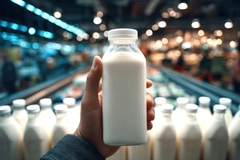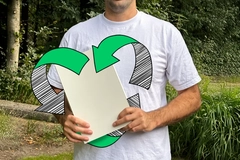Top Packaging Trends 2020: Communicating “The Language of Environmental Sustainability”

24 Mar 2020 --- In collaboration with PackagingInsights, Innova Market Insights has unveiled its Top Packaging Trends 2020, with “The Language of Environmental Sustainability” identified as this year’s leading trend. FMCG brands are increasingly finding a competitive advantage in more prominent on-pack communication of their packaging’s environmental sustainability credentials. Packaging – and its impact on the planet – are now regarded as key purchasing considerations for many global consumers. Trend two is “Plastics Come Full Circle,” which details the increasing inclusion of recycled plastics in packaging as a key component in the circular economy paradigm. Rounding off the top five trends identified by the market research specialist are “Packing an e-Punch,” “Internet of Packaging” and “Plant-based Packaging.”
Trend one: “The Language of Environmental Sustainability”
FMCG brands are increasingly acknowledging the environmental attributes of packaging as a key selling proposition of consumer packaged goods. Innova Market Insights identified “Storytelling: Winning with Words” as its top food and beverage trend for 2020, in which product packaging has become increasingly integral to brand-consumer relationships.
A 2019 Innova consumer survey found that 38 percent of Indian, German and UK consumers want to know what impact the food and beverage products they buy have on the planet. The majority of these respondents indicated that this information makes them feel more connected to the brand.
 Coca-Cola Sweden has swapped its brand logo for a “Recycle me again” message on its fully recycled bottles. Further, intensifying regulatory demand is driving the transition to more eco-friendly packaging. Notable examples include the EU’s Single-Use Plastics Ban and, more recently, its Circular Economy Action plan, which prioritizes the reduction of excessive packaging and packaging waste, and China’s strategy to phase out a broad array of single-use plastics by 2025.
Coca-Cola Sweden has swapped its brand logo for a “Recycle me again” message on its fully recycled bottles. Further, intensifying regulatory demand is driving the transition to more eco-friendly packaging. Notable examples include the EU’s Single-Use Plastics Ban and, more recently, its Circular Economy Action plan, which prioritizes the reduction of excessive packaging and packaging waste, and China’s strategy to phase out a broad array of single-use plastics by 2025.
Accordingly, brands big and small are more transparent and informative about their packaging’s carbon footprint, end of life disposal, plastic-free and renewable material credentials and using more detailed and noticeable on-pack messaging to convey this. For example, Galaxy’s Caramelised Hazelnut chocolate pack reads: “The outer card sleeve is widely recyclable. The clear NatureFlex film inside is made with wood fiber and is compostable. It breaks down in home composting within a few months and is suitable for garden and food waste collections.”
In a nod to the simple but effective approach, Coca-Cola has developed its environmental impact communication over time using snappy phrases and symbols. Before 2018, the soft drink giant included a relatively small back-of-pack recycling instruction. By 2018, bottle caps were printed with the clear message, “Please recycle.” In 2019, a prominent message on back-of-pack appeared stating, “I am 100% recyclable,” printed beneath a customized Coca-Cola recycling symbol. Further still, Coca-Cola Sweden swapped its brand logo altogether this year for a “Recycle me again” message on its fully recycled bottles.
Environmental welfare trust marks have also gained traction, with some notable additions such as the Plastic Free Trust Mark appearing more widely on packaging. This trust mark and others, including the Metal Recycles Forever and FSC-certified logos, are freely available to brands meeting the necessary criteria and provide a clear communication of environmental stewardship. For example, there has been a 25 percent average annual growth in food and beverage launches with an FSC-certified logo, according to a 2019 Innova Consumer Survey (Global, CAGR 2015-2019). Mondi and Unilever partnered to develop a PP mono-material pouch for the Knorr dry soup powder range in Turkey.
Mondi and Unilever partnered to develop a PP mono-material pouch for the Knorr dry soup powder range in Turkey.
Trend two: “Plastics come full circle”
As circular economy targets loom on the horizon, the incorporation of recycled plastics into packaging is on the rise. The UK government will introduce a Plastic Packaging Tax from April 2022 that will be enforced with financial penalties to incentivize the incorporation of recycled plastic. Meanwhile, 71 percent of Brazilian consumers believe that F&B companies should only use sustainable packaging, according to a 2019 Innova Consumer Survey.
FMCGs are investing heavily in recycled plastics in a bid to overcome universal supply and cost barriers. To “pioneer the shift from virgin plastics to food-grade recycled plastics,” Nestlé recently committed to sourcing up to 2 million metric tons of food-grade recycled plastics and allocated more than 1.5 billion Swiss francs (US$1.56 billion) to pay a premium for these materials between now and 2025.
Also, post-consumer recyclate (PCR) supply partnerships are popping up in increasing numbers around the world. Notably, Unilever has teamed up with Veolia in India and Indonesia, Berry with Georgia-Pacific Recycling in the US and Klöckner Pentaplast (kp) with Viridor in Germany and the UK.
Leading the recycled plastics race, 100 percent recycled bottles are a more common occurrence and making market entry across numerous categories. For example, German filling and packaging systems supplier KHS launched the first recyclable juice bottle made of 100 percent recycled PET (rPET) at the K 2019 show in Düsseldorf, Germany. Other packaging formats, such as containers, are making up ground, exemplified by Amcor’s launch of a 100 percent rPET container – the first in the multivitamin segment.
 Smurfit Kappa and Rollor Packaging demonstrated their crease-free garment sushi roll-inspired e-pack during Packaging Innovations 2020. Fueling a high-quality supply of PCR is a growing number of packaging solutions that are recyclable by design. Prominent here is the development of mono-material film solutions, such as Mondi-Unilever’s polypropylene (PP) mono-material pouch for the Knorr dry soup powder range and Berry bpi Group’s X-Enviro laminate range, which overcome the non-recyclable issues related to multi-material films dominating the market. “Recyclable By Design” was Innova’s top packaging trend for 2019, from which this year’s “Plastics come full circle” extends.
Smurfit Kappa and Rollor Packaging demonstrated their crease-free garment sushi roll-inspired e-pack during Packaging Innovations 2020. Fueling a high-quality supply of PCR is a growing number of packaging solutions that are recyclable by design. Prominent here is the development of mono-material film solutions, such as Mondi-Unilever’s polypropylene (PP) mono-material pouch for the Knorr dry soup powder range and Berry bpi Group’s X-Enviro laminate range, which overcome the non-recyclable issues related to multi-material films dominating the market. “Recyclable By Design” was Innova’s top packaging trend for 2019, from which this year’s “Plastics come full circle” extends.
Trend three: “Packing an e-Punch”
Incessant growth in online retail channels and the rising demand for corrugated board is taking e-commerce packaging into a brave new world. Moreover, it is opening up an array of brand enhancement opportunities, particularly through the consumer unboxing experience and so-called “wow factor” effects, played out within the wider context of increased environmental sustainability demands.
One of the driving forces in the development of superior e-commerce packaging is Amazon’s Frustration Free Packaging (FFP) scheme. Previously a voluntary scheme, Amazon now enforces its requirements for more durable and sustainable packaging through financial penalties in the US, Canada and several major European countries.
Demonstrating what is possible in e-commerce packaging NPD, Smurfit Kappa unveiled a durable paper-based solution for transporting eggs developed through its eSmart Solutions service. With “wow factor” and recyclability in mind, Smurfit Kappa also teamed up with Rollor Packaging to produce a sushi-inspired, corrugated board garment e-pack that prevents creasing.
As recyclability and end-of-life cycle become increasingly important issues for consumers, suppliers have been working on sustainable alternatives to traditionally used Styrofoam-based peanuts, commonly used for insulation and as a filler material. Notable solutions include Kompackt’s insulated packaging made from jute, which provides a Styrofoam-free mail-order solution for businesses. Further, Sealed Air showcased its redesigned, fully recyclable Mail Lite mailer at FachPack 2019, which boasts easily-separable recyclable components and a co-extruded inner bubble cushioning made of at least 60 percent recycled content. Danone brand Font Vella's Coach2O cap instructs consumers to hydrate more effectively.
Danone brand Font Vella's Coach2O cap instructs consumers to hydrate more effectively.
Trend four: “Internet of Packaging”
As IoT technologies become ubiquitous, QR codes, Near Field Communication (NFC) and blockchain are increasingly deployed as tools to elevate engagement and transparency. In China, for example, 50 percent of consumers scan QR codes several times a week, predominantly with the hope of gaining financial rewards, according to a recent SIG consumer survey.
Danone recently launched a dual QR code data service for baby formula applications that gives consumers and retailers greater transparency on the product’s farm-to-fork journey. The Track & Connect service also allows Danone to better understand consumer preferences. Also, Danone’s Spanish natural mineral water brand Font Vella introduced a cap device that tracks water intake and instructs people toward adequate hydration.
IoP technologies can also be employed to fend off food waste. Researchers at Imperial College London, UK, developed a smartphone-linked, biodegradable spoilage sensor for meat and fish packaging. A simple tap of a NFC-enabled smartphone on the package’s “Freshness Sensor” provides a digital readout of the product's actual freshness, which is determined by measuring the gases found within each sealed package.
 Based on BASF’s certified compostable ecovio, Fabbri Group produces the highly transparent stretch film Nature Fresh. Equally, IoP technologies are paving the way for a digitally-enhanced future for recycling. Most notably, several of the world’s largest brands, including PepsiCo, Nestlé and P&G, have spent the last two years collaborating with Digimarc, the company that developed an invisible barcode technology that enables enhanced sorting of different types of packaging components at recycling facilities. Fortune 500 packaging supplier Berry recently announced that it will begin manufacturing plastic packaging containing Digimarc Barcodes as a collaborator in the new recycling initiative, HolyGrail 2.0.
Based on BASF’s certified compostable ecovio, Fabbri Group produces the highly transparent stretch film Nature Fresh. Equally, IoP technologies are paving the way for a digitally-enhanced future for recycling. Most notably, several of the world’s largest brands, including PepsiCo, Nestlé and P&G, have spent the last two years collaborating with Digimarc, the company that developed an invisible barcode technology that enables enhanced sorting of different types of packaging components at recycling facilities. Fortune 500 packaging supplier Berry recently announced that it will begin manufacturing plastic packaging containing Digimarc Barcodes as a collaborator in the new recycling initiative, HolyGrail 2.0.
Trend five: “Plant-based Packaging”
Largely fuelled by anti-plastic sentiment and the desire to find more eco-friendly solutions to packaging disposal, biodegradable and compostable packaging is hitting the market in higher numbers and with increased sophistication. European Bioplastics (EUBP) forecasts “dynamic growth” in the global bioplastics industry, in which packaging remains the largest field of application with almost 53 percent of the total bioplastics market in 2019.
Innova Market Insights records a 16.4 percent growth in F&B products using biodegradable packaging and a 53.9 percent growth in compostable options (Global, CAGR 2015-2019). Within this, more than 50 percent of F&B launches with compostable packaging claims fall in the snacks and confectionery category. Camvac's home-compostable decorative metalized film.
Camvac's home-compostable decorative metalized film.
Cellulose-based packaging is at the forefront of plant-based innovations, with the likes of PulPac’s 3D dry molded technology offering renewable and cost-effective alternatives to plastics in coffee cup lids, coffee pods, food trays and more.
In February, major bioplastics players BASF and Novamont both launched highly sustainable solutions for fresh-food packaging in two major compostable cling film breakthroughs. Tackling both plastic pollution and food waste simultaneously, BASF’s certified compostable ecovio material and Novamont’s MATER-BI material replace hard-to-recycle conventional plastics like polyethylene (PE) while increasing product shelf-life.
In other notable launches, Camvac unveiled Cambrite Camvert, a fully biodegradable and home-compostable decorative metalized film at Packaging Innovations 2020. Also, Monta developed a certified biobased self-adhesive tape made from around 90 percent renewable raw resources.
By Joshua Poole











